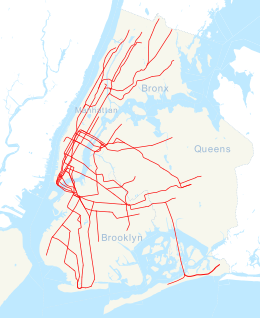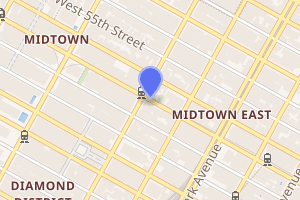Fifth Avenue/53rd Street station
Fifth Avenue/53rd Street is a station on the IND Queens Boulevard Line of the New York City Subway. Located at the intersection of Fifth Avenue and 53rd Street in Manhattan, it is served by the E train at all times and the M train weekdays except late nights.[4][5]
5 Avenue/53 Street | |||||||||
|---|---|---|---|---|---|---|---|---|---|
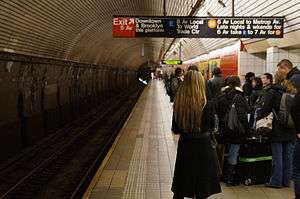 People waiting for a train on the upper level platform | |||||||||
| Station statistics | |||||||||
| Address | Fifth Avenue & 53rd Street New York, NY 10019 | ||||||||
| Borough | Manhattan | ||||||||
| Locale | Midtown Manhattan | ||||||||
| Coordinates | 40.76028°N 73.97556°W | ||||||||
| Division | B (IND) | ||||||||
| Line | IND Queens Boulevard Line | ||||||||
| Services | E M | ||||||||
| Transit connections | |||||||||
| Structure | Underground | ||||||||
| Levels | 2 | ||||||||
| Platforms | 2 side platforms (1 on each level) | ||||||||
| Tracks | 2 (1 on each level) | ||||||||
| Other information | |||||||||
| Opened | August 19, 1933 | ||||||||
| Station code | 276[1] | ||||||||
| Accessibility | Same-platform wheelchair transfer available | ||||||||
| Wireless service | |||||||||
| Opposite-direction transfer available | Yes | ||||||||
| Traffic | |||||||||
| Passengers (2019) | 7,684,091[3] | ||||||||
| Rank | 47 out of 424[3] | ||||||||
| Station succession | |||||||||
| Next east | Lexington Avenue–53rd Street: E | ||||||||
| Next west | Seventh Avenue (8th Avenue): E 47th–50th Streets–Rockefeller Center (6th Avenue): M | ||||||||
| |||||||||
| |||||||||
| |||||||||
Fifth Avenue/53rd Street was opened in 1933 as part of the Independent Subway System (IND)'s Queens Boulevard Line. It contains two side platforms on separate levels: southbound trains to Lower Manhattan use the upper level, while northbound trains to Queens use the lower level. The station was renovated in the 1980s as part of the Metropolitan Transportation Authority's Culture Stations program, and was rebuilt with displays showing information about the cultural institutions in the area.
History
Opening
This station opened on August 19, 1933 with the opening of the IND Queens Boulevard Line to Roosevelt Avenue in Queens. Service was initially provided by E trains running via the IND Eighth Avenue Line.[6] On December 15, 1940, the IND Sixth Avenue Line opened between West Fourth Street–Washington Square and 59th Street–Columbus Circle. On this date, F trains began using this station, diverging west of the station onto the Sixth Avenue Line.[7][8]
In 1959, a project started to replace the four 2-foot-wide (0.61 m) escalators with new wider 4-foot-wide (1.2 m) escalators—two at the Madison Avenue end of the station, and two at the Fifth Avenue end.[9] The new 94-foot (29 m) long escalators were intended to increase capacity, and could run at speeds of 90 or 120 feet (27 or 37 m) per minute. On September 8, 1959, the first of the four new 4-foot-wide escalators was put into place at the Madison Avenue entrance, replacing one of the 2-foot-wide escalators. The entire project cost $1.2 million. As part of the project, other improvements were made: the lighting at the station was replaced with fluorescent lighting, and the stairways at the station were moved.[10]
Renovation

In 1981, the Metropolitan Transportation Authority (MTA) listed the station among the 69 most deteriorated stations in the subway system.[11] That same year, the MTA announced the creation of its Culture Stations program to install public art in the subway. The Culture Stations program was started to deter graffiti, and was inspired by legislation in the New York City Council that mandated that 1% of the cost of constructing public buildings be used for art. The program was modelled on the Louvre – Rivoli station on the Paris Métro, which featured reproductions of the artwork on display in the Louvre. Four stations, including this station, Astor Place, Eastern Parkway–Brooklyn Museum and 66th Street–Lincoln Center, were selected for the program due to their proximity to cultural institutions,[12] and would be among the first stations part of the MTA's new station refurbishment program, which began in 1982.[13] The Fifth Avenue station was chosen for its proximity to five museums, the New York Public Library Main Branch, and major corporations.[14]
The stations part of the Culture Stations program were to be completed by making use of both private and public funding. This station was redesigned by Lee Harris Pomeroy Architects.[15] The modernization project was opened to bidders on November 9, 1982, and was expected to cost between $4 and $6 million.[16] Design work was completed in 1983. The renovation was originally scheduled to be complete in December 1984 but was pushed back by two years.[17] As part of the renovation, 400-foot-long (120 m) rows of light boxes containing displays showing information about objects in nearby museums such as the Museum of Modern Art, as well as points of interest in the vicinity, were installed on each platform.[14] The light boxes were designed by the project's graphic designers, Pentagram. In addition, to prevent water seepage and to reduce noise, double layered metal linings were installed in the station.[14]
In 1996, Ralph Fasanella's 1950 painting "Subway Riders" was installed outside fare control in the full-time mezzanine.[18] It was the first oil painting installed in a subway station in New York City. Fasanella had donated it to the American Folk Art Museum on the condition that it stay permanently displayed in the subway under the MTA Arts & Design program, saying, "I'd rather have people see this painting in the subway than any museum."[19] In 2014, "Subway Riders" was temporarily removed and placed in a traveling exhibition called "Self Taught Genius: Treasures From the American Folk Art Museum".[19]
Proposed improvements
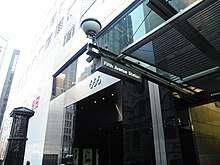
As part of the rezoning of East Midtown, which was approved in 2017, developers were permitted to construct buildings at the maximum permitted floor area ratio if they transferred landmark development rights, rebuilt overbuilt floor area, or made pre-identified improvements to subway stations in the area. The six stations chosen for improvements (Grand Central–42nd Street, Lexington Avenue/51st Street, 42nd Street–Bryant Park/Fifth Avenue, 47th–50th Streets–Rockefeller Center, Lexington Avenue/59th Street, and Fifth Avenue/53rd Street) were prioritized due to high ridership. Improvement projects include making stations compliant with the Americans with Disabilities Act of 1990, improving circulation and wayfinding, and reducing congestion by constructing new entrances, or by installing escalators and wider staircases.[20] A list of three levels of improvements were created by the MTA and the New York City Department of City Planning. Type 1 improvements would give a developer 40,000 square feet (3,700 m2) of additional floor area, Type 2 improvements would give them an additional 80,000 square feet (7,400 m2), and Type 3 improvements would give them an additional 120,000 square feet (11,000 m2).[21]
Initially, in 2012, two improvements were considered for the Fifth Avenue station. These would entail adding or widening stairs between the upper and lower level platform at the east end of the station, and adding or widening the escalators between the upper level platform and the Madison Avenue mezzanine. The main reasoning for the first of the two improvements was because that staircase is over capacity, clearing in 75 seconds during the morning rush hour, greater than the 45 second guideline. The reasoning of the second was because the escalators are at capacity, and would become over capacity if the capacity of the staircase between the two levels was increased.[22]
The approved East Midtown rezoning provides for one Type 1 improvement, and five Type 2 improvements at this station. The Type 1 improvement would be the construction of a new street entrance on 53rd Street west of Madison Avenue. One of the Type 2 improvements would be the construction of a new staircase between the upper level platform and the mezzanine, and a new staircase between the upper and lower level platforms. Developers could also elect to install an elevator between the mezzanine and the two platforms. Another potential improvement considered would be the installation of two escalators between the upper level platform and the mezzanine.[21] One proposed project would construct a new mezzanine under 53rd Street with a new fare control area to accommodate the new entrance west of Madison Avenue and a new access core. This access core would be constructed in a separate project, and would provide access between the new entrance and the platforms, accommodating new staircases, an elevator and escalators.[21]
Station layout
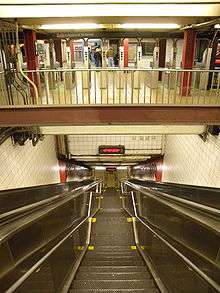
| G | Street level | Exit/entrance |
| B1 | Mezzanine | Fare control, station agent |
| B2 | Southbound | ← ← |
| Side platform | ||
| B3 | Northbound | |
| Side platform | ||
This underground station has two levels, with the upper level serving trains bound for Lower Manhattan and the lower level serving trains bound for Queens. Each level has one track and one side platform.[23] The upper level, built in a tube design, is 59 feet (18 m) below street level while the lower level is 80 feet (24 m) below.[10] Staircases connect each level at both ends.[24]
There is a junction just west (railroad south) of this station that is controlled by a tower on the south end of the upper level platform. E trains continue west along 53rd Street while M trains turn south and enter the IND Sixth Avenue Line.[23]
Exits
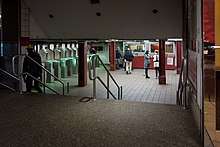
The station has two entrances/exits. The full-time exit at Fifth Avenue is at the west (railroad south) end of the platform level. Two 94-foot (29 m) long escalators[10] and one staircase go up to a turnstile bank, where a token booth is present. A passageway leads to two staircases going up to the eastern corners of Fifth Avenue and 53rd Street. There is another staircase that leads to the underground shopping arcade of 666 Fifth Avenue, which has an entrance/exit on the south side of 53rd Street west of Fifth Avenue.[25]
The part-time entrance/exit leads to Madison Avenue and is located at the east (railroad north) end of the station. This exit has a turnstile bank, customer assistance booth, and two staircases, both of which are built within underground shopping arcades,[26] going up to both eastern corners of Madison Avenue and 53rd Street.[25] Two 94-foot (29 m) long escalators connect the upper-level platform and the mezzanine.[10]
The part-time exit is only open on weekdays and Saturdays until 9:45 p.m.[27] The street-level gates to the station were owned by private companies who formerly closed them at 9 p.m. However, MTA workers did not close the platform-level gates until 10 p.m. During the hour in between the two gates' closures, exiting passengers often became trapped after passing through the turnstiles, forcing them to go back into the subway–either paying another fare or jumping the turnstiles. After the MTA was informed of the issue in 2013, it arranged with the building owners to keep the exit open until 9:45 p.m. and the signs in the station were updated accordingly.[28]
Notable places nearby
- Austrian Cultural Forum New York[25]
- Fifth Avenue Presbyterian Church[25]
- Friars Club[25]
- Hotel Elysée[25]
- La Grenouille[25]
- Lever House[25]
- Museum of Modern Art[25]
- Paley Center for Media[25]
- Peninsula Hotel[25]
- Racquet and Tennis Club[25]
- Sony Building[25]
- St. Patrick's Cathedral[25]
- St. Regis Hotel[25]
- Trump Tower[25]
References
- "Station Developers' Information". Metropolitan Transportation Authority. Retrieved June 13, 2017.
- "NYC Subway Wireless – Active Stations". Transit Wireless Wifi. Retrieved November 13, 2019.
- "Facts and Figures: Annual Subway Ridership 2014–2019". Metropolitan Transportation Authority. 2020. Retrieved May 26, 2020.
- "M Subway Timetable, Effective November 17, 2019" (PDF). Metropolitan Transportation Authority. Retrieved January 16, 2020.
- "E Subway Timetable, Effective November 17, 2019" (PDF). Metropolitan Transportation Authority. Retrieved January 16, 2020.
-
- "Two Subway Units Open At Midnight; Links in City-Owned System in Queens and Brooklyn to Have 15 Stations" (PDF). The New York Times. August 18, 1933. ISSN 0362-4331. Retrieved November 7, 2015.
- "New Queens Subway Service Will Be Launched Tonight; Tunnel From Manhattan Open to Jackson Heights; Service Will Eventually Be Extended Through To Jamaica" (PDF). Long Island Daily Press. August 18, 1933. p. 20. Retrieved July 27, 2016.
- "New Queens Tube To Open Saturday: Brooklyn-Long Island City Link of City Line Also to Be Put in Operation" (PDF). New York Evening Post. August 17, 1933. p. 18. Retrieved July 27, 2016.
- Sparberg, Andrew J. (October 1, 2014). From a Nickel to a Token: The Journey from Board of Transportation to MTA. Fordham University Press. ISBN 978-0-8232-6190-1.
-
- Linder, Bernard (December 2008). "Sixth Avenue Subway Service Changes". New York Division Bulletin. Electric Railroaders' Association. 51 (12): 2–4. Retrieved August 6, 2016.
- "New 6th Ave. Tube Will Be Boon to Queens Residents". The Brooklyn Daily Eagle. December 8, 1940. p. 10. Retrieved October 4, 2015.
- "New York City Transit Authority Annual Report for the year July 1, 1958 to June 30, 1959" (PDF). New York City Transit Authority. October 1959. pp. 7, 9, 10. Retrieved April 2, 2018 – via nycsubway.org.
- "IND 5th Ave. Station Gets Big Escalator". The New York Times. September 9, 1959. ISSN 0362-4331. Retrieved April 2, 2018.
- Gargan, Edward A. (June 11, 1981). "Agency Lists Its 69 Most Deteriorated Subway Stations". The New York Times. Retrieved August 13, 2016.
- Fitzpatrick, Tracy (2009). Art and the Subway: New York Underground. Rutgers University Press. p. 229. ISBN 9780813544526.
- "Untangling Knots in the Subway; Architect's Challenge Is to Make DeKalb Station Flow". The New York Times. February 3, 2000. ISSN 0362-4331. Retrieved September 12, 2019.
- Interiors. Billboard Publications. 1986. p. 120.
- "Lee Harris Pomeroy, 85, Dies; Architect Revived Subway Stations". The New York Times. February 25, 2018. ISSN 0362-4331. Retrieved September 12, 2019.
- "Bid Dates". Engineering News-record. McGraw-Hill. 209 (15–20): 42. November 1982.
- "Transit System Repairs Produce Mixed Results". The New York Times. November 23, 1986. ISSN 0362-4331. Retrieved September 12, 2019.
- "NYCT Permanent Art Fifth Avenue-53rd Street". mta.info. Metropolitan Transportation Authority. Retrieved April 2, 2018.
- Grimes, William (May 7, 2014). "Commute for Subway Art Is Three Years, Door to Door". The New York Times. ISSN 0362-4331. Retrieved September 14, 2019.
- "Greater East Midtown Proposal City Council Public Hearing June 20, 2017" (PDF). nyc.gov. New York City Department of City Planning. June 20, 2017. pp. 9, 20, 21. Retrieved September 12, 2019.
- "Technical Memorandum 003 Greater East Midtown Reznoning CEQR No. 17DCP001M ULURP Nos.: N 170186(A) ZRM and C 170187 ZMM August 4, 2017" (PDF). nyc.gov. New York City Department of City Planning. August 4, 2017. Retrieved September 12, 2019.
- "Potential East Midtown Transit Improvements October 2012". Metropolitan Transportation Authority. October 2012. Retrieved September 12, 2019.
- Dougherty, Peter (2006) [2002]. Tracks of the New York City Subway 2006 (3rd ed.). Dougherty. OCLC 49777633 – via Google Books.
- See, for instance:
- Cox, Jeremiah (December 28, 2008). "Staircase for the Lexington Avenue & Queens platform". Retrieved April 2, 2018 – via Subway Nut.
- Cox, Jeremiah (June 22, 2009). "At the Madison Avenue end of the stations unusual signs for the 5 Avenue exit". Retrieved April 2, 2018 – via Subway Nut.
- "MTA Neighborhood Maps: 5 Av/53 St (E)(M)" (PDF). mta.info. Metropolitan Transit Authority. April 2018. Retrieved July 28, 2016.
- Cox, Jeremiah (May 20, 2010). "The entrance inside 509 Madison Avenue with signs about its shopping arcade". Retrieved March 21, 2018 – via Subway Nut.
- Cox, Jeremiah (July 14, 2013). "The Madison Avenue exit, closed on Sundays. The reason is because it leads to a private atrium that isn't open 24 hours a day". Retrieved April 2, 2018 – via Subway Nut.
- Flegenheimer, Matt (February 27, 2013). "5th Avenue Subway Station Traps Unwary Riders Behind Locked Exit". The New York Times. ISSN 0362-4331. Retrieved April 2, 2018.
External links
| Wikimedia Commons has media related to 5th Avenue/53rd Street (IND Queens Boulevard Line). |
